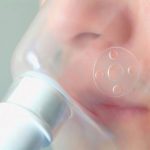 A pathological swelling caused by accumulation of air or gas in tissue spaces. In the oral cavity and facial region, it may be initiated by the unintentional introduction of air into a tooth socket or gingival crevice with an air syringe, an air‐driven dental handpiece, a continuous positive airway pressure or bilevel positive airway pressure machine, coughing, or nose blowing.
A pathological swelling caused by accumulation of air or gas in tissue spaces. In the oral cavity and facial region, it may be initiated by the unintentional introduction of air into a tooth socket or gingival crevice with an air syringe, an air‐driven dental handpiece, a continuous positive airway pressure or bilevel positive airway pressure machine, coughing, or nose blowing.
A chronic respiratory disease in which there is a perpetual dilation of the respiratory alveoli in the lung, causing a reduction in lung function and frequently breathlessness.
A lung disease causing thinning and loss of elasticity of the lung tissue.
A pulmonary condition with loss of elasticity in the alveoli and the interalveolar septa-the meat-foam and their interleaving sheaths that you fill up when you breathe. If a septum gets too stretched over time, several of the little sacs will coalesce together, decreasing the surface area for oxygen and carbon dioxide exchange. If enough of these sacs lose their separateness, breathing gets harder because each breath accomplishes less interchange of gases, resulting in emphysema. Caused by years of bad asthma, tobacco smoking, chemical damage, and other chronic lung disorders, it can be halted but not reversed.
Enlargement of air vesicles in the lungs; swelling of connective tissues of the body caused by to the presence of air.
A condition in which the alveoli of the lungs become distended and/or ruptured and unable to hold or accept normal quantities of oxygen.
A condition in which the walls of the alveoli of the lungs break down, reducing the surface available for gas exchange and resulting in a lower oxygen level in the blood and shortness of breath. It can be caused by smoking, living in a polluted environment, old age, asthma or whooping cough.
Lung disease resulting in large holes in the air sacs of the lungs.
A kind of lung and breathing disorder, one type of which—congenital lobar emphysema—affects newborns.
Abnormal condition of the lungs in which there is over-inflation of the air sacs (alveoli) of the lungs, leading to a breakdown of their walls, a decrease in respiratory function, and, in severe cases, increasing breathlessness. Emphysema appears to be associated with chronic bronchitis, smoking, and advancing age; one form that occurs early in life is related to a hereditary lack of an enzyme. Early symptoms of emphysema include dyspnea, cough, rapid heart rate; advanced cases are marked by signs of oxygen insufficiency (restlessness, weakness, confusion) and frequently by complications of pulmonary edema and congestive heart failure. Breathing exercises, drugs such as bronchodilators, and the prevention of respiratory infections may be helpful; severe cases may require oxygen.
Chronic and irreversible damage to alveoli characterized by trapped air in the lung; productive cough, often due to smoking or pollution.
Enlargement of the air sacs in the lungs, causing respiratory difficulty as the condition progresses.
A chronic lung disease characterized by destruction of the walls of the alveoli, or air sacs, in the lungs, resulting in over-inflation of the air sacs. Emphysema occurs gradually, usually as a result of years of exposure to cigarette smoke. The disease process causes gradual irreversible damage that interferes with the normal exchange between oxygen taken from the air breathed in and the carbon dioxide in the blood. Less oxygen is transferred from the lungs into the bloodstream, and overexpansion of the chest makes it difficult for a person to breathe, causing shortness of breath.
The presence of air in the body’s tissues. Divided into two types, surgical and pulmonary emphysema, the former occurs when air escapes from leaks in the lungs and oesophagus perhaps as the result of injury or infection and collects in the tissues of the chest and neck. Air occasionally escapes into other tissues as a result of surgery or injury, and bacterial infection can also produce gas in soft tissues. Air or gas gives the affected tissue an unmistakable crackling feel when touched, and commonly develops in an individual after blowing up balloons. X-rays of an affected area will usually show the presence of air. Such air is generally absorbed by the body when the leak has been sealed.
A respiratory disease in which air cannot move in and out of alveoli because they become blocked or lose their elasticity.
A breathing disorder in which the small air sacs in the lungs lose their ability to expand and contract.
A chronic obstructive pulmonary disease characterized by the abnormal enlargement of air sacs within the lungs, resulting in diminished gas exchange capability and a tendency to retain air. Symptoms of this condition include difficulty in breathing, an inability to exhale forcefully, and an elevated vulnerability to respiratory tract infections.
The unusual occurrence of air or gas within body tissues. It can be identified by the sensation of a crackling feeling when pressure is applied to the affected area with the fingers.
